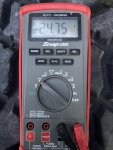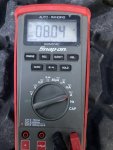I was referring to your dash gauges working with the dash battery switch turning on/off as being perfect, as you said it formerly did not do that.
There is a lot more going on with this truck than just the alternator. Owner said he had to drive it on the stock over-charging alternator for a while, so you won’t know what that damaged by doing so. Tough spot, no easy way to disconnect it temporarily during a drive and reconnect later on the drive. Belt drives water pump as well.
Then a report of the dash switches not controlling the engine correctly.
Then a report of PCB rebuild without reinstalling the high voltage flyback protection diodes.
Then the truck operating properly if the alternator is connecting directly to battery and not using the vehicle harness. Dash switches did not work, but then magically did the next time.
Then an observation of the dash voltmeter in the low yellow even though the charging system seems to be working and even a bit high (explained below).
Then a report that the batteries are very weak.
The new replacement alternators have a temperature compensated voltage regulator. The colder the ambient air around the alternator is, the higher the voltage setpoint is. After start, as it runs and warms up, the regulated voltage typically reduces. This is because they want to recharge the batteries after start as fast as possible, without boiling the acid in them. So, a colder regulator has a higher setpoint, a warmer one will be lower. This takes more than a few minutes of running to do so. Alternator itself has to be pretty warn.
There is more going on with this truck electrically than just the alternator replacement. The truck really needs a few hours spent on it diagnosing what is or went wrong, what got damaged, and fixing it. That really can’t be done over the internet, phone, or text. It needs to be done using the schematics, a meter, observations, electrical know-how, and climbing around the truck checking things. Roping in opinions of a bunch of different people and getting them fighting is not the way to do it. Connecting the alternator to the starter is OK, will work, and is how new trucks are wired. But that does not explain or correct the several other points observed and stated above, which are all outside of the alternator arena.
This is exactly why I quit advertising alternator kits a long time ago. You are then immediately on the hook for anything electrically wrong with everybody’s 30 year old trucks, from headlights to taillights. The alternator is $120, the Cummins upper bracket is $100, pulley $15, shipping is $40, lower brace and hardware is $10. $15 profit is just not worth it anymore.
People here want to be as helpful as we can, but nobody can actually fix it from states away. Different people will have different opinions and experiences, especially with electrical stuff that is not tangible. Simp has a lot of experience with these trucks and working on them, but Tow is actually correct in his charging voltage statements. 32v is a pinch too high for continuous warm running, but is OK for an open air cold start measurement. Take the truck for a long drive with the hood closed (more than 15 minutes), and remeasure once the alternator is warm to the touch. Get the batteries charged back up, get your low dash volt gauge reading correctly (ground issue?), get your dash switches working properly, get diodes back on your PCB solenoids. It should be lower than 32v running once warmed up.






